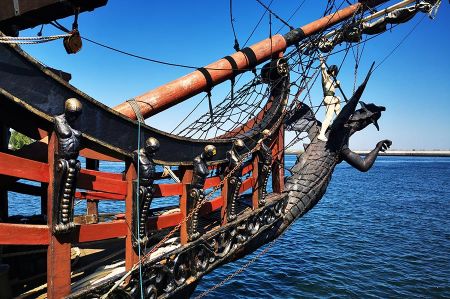Pirate galleon in the port of Gdynia
- Written by Portal Editor
As a child of the coast, you are of course familiar with sailing ships of various categories and sizes, and we also reported on the three-masted Pomorza, which attracts so many visitors here in the port of Gdynia.
However, we did not expect that we would come across a galleon a little later. The galleon was once a manoeuvrable, fearsome warship that was also often used by pirates.
Galleons also often "taken over" by pirates
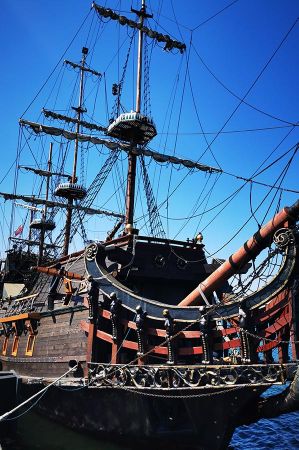 Originally developed in Spain in the 16th century, the galleon was a three-masted sailing ship that was an extraordinarily manoeuvrable, fast and ocean-going warship for the time. Even if it looked more like a merchant ship.
Originally developed in Spain in the 16th century, the galleon was a three-masted sailing ship that was an extraordinarily manoeuvrable, fast and ocean-going warship for the time. Even if it looked more like a merchant ship.
Due to its superior military properties, however, the galleon was adopted by almost all seafaring nations in Europe and developed further independently.
In the 16th and 17th centuries, galleons were initially used primarily in Spain, Portugal and later in other countries as seaworthy war and privateer ships. We know from history that pirates often acted on behalf of certain rulers, so "acquiring" galleons was often easy. The Spanish used galleons, among other things, to transport troops and equipment to America and the Far East.
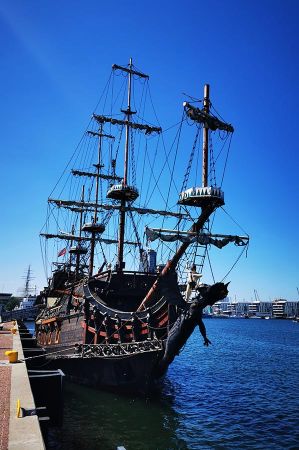 Since the Spanish ships loaded with treasure were repeatedly exposed to attacks on the return journey, especially by English, French and Dutch pirates and privateers, the Spanish began to use large warships, defensive galleons, as transporters.
Since the Spanish ships loaded with treasure were repeatedly exposed to attacks on the return journey, especially by English, French and Dutch pirates and privateers, the Spanish began to use large warships, defensive galleons, as transporters.
The Spanish increasingly built very large galleons such as the Manila galleons for this purpose. This is why the galleon is often wrongly interpreted as a merchant ship.
The origin of the galleon is still largely unknown, even to researchers. The ship type is likely to have been created by combining the fighting power of the large carracks with the good sailing characteristics of the smaller caravels in Spain or Portugal.
Nothing is known for certain about the origin of the word galleon itself. However, it is suspected that the name is derived from the galleon, which is an essential feature of the ship type.
The name probably comes from the imposing bow - the galleon
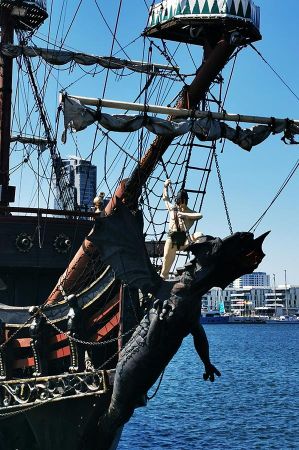 A galleon is a platform with a railing that extends over the bow of the sailing ship. The first ships with galleons were built in Europe around 1500.
A galleon is a platform with a railing that extends over the bow of the sailing ship. The first ships with galleons were built in Europe around 1500.
The galleon may have originated from the ram of the galleys, but perhaps part of the front structure of a carrack was cut down to make room for the blind, a square sail that was sailed under the bowsprit.
While the figurehead was initially functional and plain and grew straight out of the bow of the ship, it became increasingly more elaborate, especially on the representative warships of the 17th and 18th centuries - with elegantly curved figurehead rails, gilded carvings and, above all, a figurehead that often represented a personification or allegory of the ship's name.
Boarding enemy ships - initially man to man
 Battle at sea was essentially about boarding enemy ships and conquering them in close combat with superior crews.
Battle at sea was essentially about boarding enemy ships and conquering them in close combat with superior crews.
Guns were only used to decimate the enemy crew shortly before boarding the enemy.
Loading and firing these cannons alone could take up to 30 minutes, completely different to what is portrayed in many pirate films. Under these conditions, high, castle-like fore and aft castles were important, which were difficult to conquer and from which the enemy could be shot at.
However, these ships were initially very susceptible to crosswinds, difficult to manoeuvre and extremely top-heavy. With the construction of the galleon, these deficiencies were remedied for use in the Atlantic.
 When the early galleons were built, cannons usually had small and different calibres and were not very accurate.
When the early galleons were built, cannons usually had small and different calibres and were not very accurate.
Sea battles were still decided by boarding, with the fighters on a larger and higher ship having a clear advantage. Therefore, the older galleons were built a little higher, which made them more cumbersome and not yet as seaworthy.
When cannons, whose bullets could penetrate a ship's hull, became popular towards the end of the 16th century, the days of the boarding ship were numbered.
A ship with superior artillery could keep its opponent at a distance, so that its perhaps larger boarding party was not even deployed. As a result, the galleons were built lower and were increasingly equipped with heavy guns.
Enough about our excursion into the history of galleons.
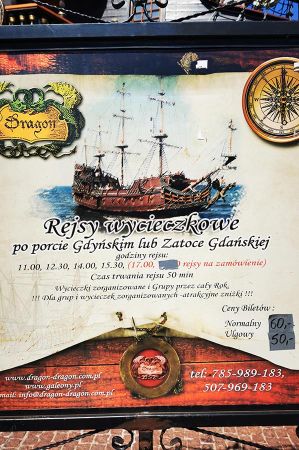 But what is the deceptively realistic replica galleon, which has been expanded with numerous cannons, doing in the port of Gdynia?
But what is the deceptively realistic replica galleon, which has been expanded with numerous cannons, doing in the port of Gdynia?
In short: a tourist attraction that invites you to take a tour of the harbour. And who hasn't dreamed of traveling on a real pirate ship? So it's clear that many families use this galleon to relax during a harbour tour.
There is a lot for the children to discover, making the harbour tour a special adventure.
Something for you too? Have fun!
Please read as well:
Osłonino – formerly a fishing and landing place for Kashubians
Marseilles and the Plage du Prado – a positive surprise
-
 Pirates at the harbour of Gdingen
Pirates at the harbour of Gdingen
Pirates at the harbour of Gdingen
Pirates at the harbour of Gdingen
-
 Pirates at the harbour of Gdingen
Pirates at the harbour of Gdingen
Pirates at the harbour of Gdingen
Pirates at the harbour of Gdingen
-
 Pirates at the harbour of Gdingen
Pirates at the harbour of Gdingen
Pirates at the harbour of Gdingen
Pirates at the harbour of Gdingen
-
 Pirates at the harbour of Gdingen
Pirates at the harbour of Gdingen
Pirates at the harbour of Gdingen
Pirates at the harbour of Gdingen
-
 Pirates at the harbour of Gdingen
Pirates at the harbour of Gdingen
Pirates at the harbour of Gdingen
Pirates at the harbour of Gdingen
-
 Pirates at the harbour of Gdingen
Pirates at the harbour of Gdingen
Pirates at the harbour of Gdingen
Pirates at the harbour of Gdingen
-
 Pirates at the harbour of Gdingen
Pirates at the harbour of Gdingen
Pirates at the harbour of Gdingen
Pirates at the harbour of Gdingen
-
 Pirates at the harbour of Gdingen
Pirates at the harbour of Gdingen
Pirates at the harbour of Gdingen
Pirates at the harbour of Gdingen
-
 Pirates at the harbour of Gdingen
Pirates at the harbour of Gdingen
Pirates at the harbour of Gdingen
Pirates at the harbour of Gdingen
https://www.alaturka.info/en/poland/gdansk/6654-pirate-galleon-in-the-port-of-gdynia#sigProId595ad8b70d
